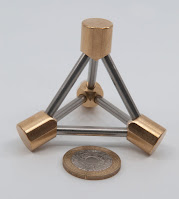A design from Oskar van Deventer brought to life in heavy metals by the Two Brass Monkeys?
SURE!
Why not?
Enter Tetrahedrane... a close relative of Oskar’s 3D-printed Screwballs, and confusingly Screwballs Too, that doesn’t actually have any balls – rather it has rhombic dodecahedra at each of the tetrahedron’s vertices. In that sense Tetrahedrane might well be called Screwballs Tree... and somewhere along the path from 3D-printed plastic to brass and steel the name got an upgrade to reference a mythical hydrocarbon of the same shape.
My copy arrived in the mail some time back, slightly ahead of its public release so I could take some pics for the lads’ website... and if you look at said website you’ll notice there are only pictures of the fully assembled puzzle, as it arrives... that’s not because I didn’t have enough time to take it apart, or because my copy was somehow magically jammed up, it was simply because I was too scared to take it apart in case that was how it would end up staying for quite some time.
After staring at it on my desk for a couple of weeks I decided that the time had come and I should face my fears, or at very least, take my copy of Tetrahedrane apart. It took a little backwardsing and forwardsing but once you’ve got three of the ends off, the rest is pretty straight-forward. And that leaves you with a little pile of parts – far more compact, but not nearly as good-looking!At this point I pause to think about things a bit: this is an interesting puzzle, as in theory, if there was zero tolerance, you’d need to manipulate all sides at the same time – I’m not giving anything away here – all of the descriptions of the puzzle and its predecessors tell you the sides screw into the balls / rhombic dodecahedra / sorta-cylinders – so you’d need to expand or contract all of the sides at the same time for anything to come apart / go together.
So in theory this is a very tricky puzzle for anyone with only two hands to assemble... in practice, the theory doesn’t get in the way all that much – as we’ve seen in some analogous two-dimensional puzzles. Sure it’s a bit tricky and you need to be patient about things, but patience and a methodical approach will take things apart for you...
When you have a pile of pieces, it’s worth thinking about things and taking stock of exactly what you have – you’ll probably find some things are all identical and others are all different... and that is sufficient to derive exactly how the different bits need to be connected to the identical bits.
Solving it in theory is one thing, but solving it in practice isn’t too much harder, just a bit fiddlier.
Am I embarrassed that I didn’t just disassemble it straight away?
Yes. A little.
...but then this blog post would have been a lot shorter!


No comments:
Post a Comment